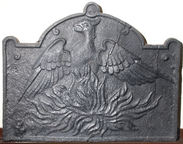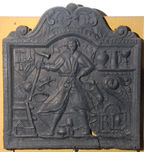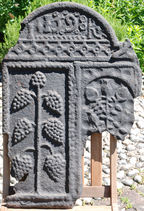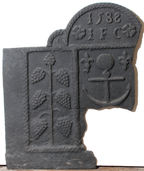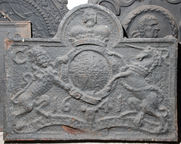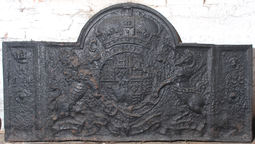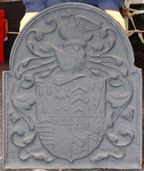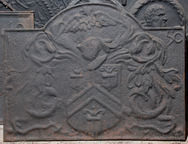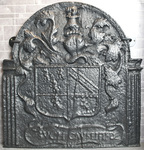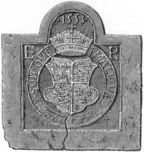-
409
Description: Quasi-arched rectangular shape, semi-circular protrusions on top corners; circular loop at top of arch; fillet edging with small twists inside arch, and curls inside and below top corners; a phoenix in flames, its wings displayed and inverted.
Notes: The use of the loop in the edging draws comparisons with other firebacks, and may indicate the same source. Formerly part of the J. H. Every collection.
- Decoration tags:
- rectangular with round arch (shape)
- fillet (edging)
- whole carved pattern
- planklines
- pictorial
- mythological
- animals
Manufactured: in the mid- to late-17th century possibly in the Weald area of England.
Current location: Anne of Cleves House, Southover High Street, Lewes, e, England.
Museum number: 1944.24.061 (part of the Sussex Archaeological Society museum group)
- Attached to series:
- Loop edged firebacks
- Phoenix firebacks
-
429
Description: Arched rectangular shape with symmetrical floral scrolls on top; three horizontal plank lines; ovolo moulding all round edge of main panel; inscription along top edge of panel; central figure of a bearded man wearing knee-length coat, belted at waist, and holding a sledge hammer in his right hand, his left arm akimbo; both feet pointing to his right; various ‘tools’ of his trade arranged about him; (clockwise from top left) shield, the quarters containing a masonry hammer, a firedog, a weight, and a pair of pincers; the date split on either side of his head; a floral console supporting a shelf bearing a flagon, a tankard and a goblet; a fireback bearing the letters RL and a diamond shape; from the top of the fireback a dog leaping up at its master; between the man's legs a long-handled ladle, a weight and a cooking pot; a ringer, used to pull slag off molten iron; part of the elevation of a blast furnace, with wooden framework, casting house, and flames issuing from the top; an ore basket, wheelbarrow and a charcoal clamp
Notes: The 'Lenard' fireback; a much-copied plate. Items relating to the founder's working life are displayed to the left of the figure, those to the right reflecting his domestic life. Its individualistic design and naïve figuration are the key to identifying a distinct group of firebacks, all probably made at Brede. A pastiche of this fireback also exists (no. 668), with which it is sometimes confused.
Copies of this fireback are known.
Inscription: RICHARD LENARD FOVNDER AT BRED FOVRNIS [each D is reversed] / 1636 / RL
- Decoration tags:
- rectangular with round arch (shape)
- ovolo (edging)
- whole carved pattern
- planklines
- pictorial
- historical
- text
- animals
- humans
- objects
Manufactured: in 1636 at Brede Furnace in the Weald area of England.
Current location: Anne of Cleves House, Southover High Street, Lewes, East Sussex, England.
Museum number: LH000.906 (part of the Sussex Archaeological Society museum group)
Citation: Anon., 30 Dec 1911, 'Sussex Backs and their Story', The Ironmonger.
Citation: Dawson, C., 1903, 'Sussex Iron Work and Pottery', Sussex Archaeological Collections, 46, pp. 1-54.
Citation: Gardner, J. S., 1898, 'Iron Casting in the Weald', Archaeologia, 56, 1, pp. 133-164.
- Attached to series:
- Brede group
- Personal firebacks
-
430
Description: Fragment; to the left, rectangular panel with braid edging, vine standard with six bunches of grapes and a cluster at the top; to the right, rectangular panel with wide fillet edging, arched recess with three flower heads in low relief, and in the arch spandrels four 'bullseye' motifs comprising concentric rings deepening towards the centre; on top, a semi-circular panel with fillet edging, within which are the date between the initials, with scattered small rings, below is a pattern of eight linked circles; vestige of another semi-circular panel to the left.
Notes: Potentially a fragment of a large fireback, the vestige of a second semi-circular arched panel on top offers the possibility that several other panels originally existed further to the right. The two surviving panels combine elements from two separate sub-groups of firebacks that were moulded from individual, interchangeable panels, indicating that the sub-groups originated from a common source.
Inscription: I 1598 R
- Decoration tags:
- rectangular with round arch (shape)
- astragal (edging)
- carved pattern panels
- text
- plants
Manufactured: in 1598 in the Weald area of England.
Current location: Anne of Cleves House, Southover High Street, Lewes, East Sussex, England.
Museum number: 1944.24.083 (part of the Sussex Archaeological Society museum group)
- Attached to series:
- Armada series
-
439
Description: Fragment; left part only; this fireback comprises at least four separate elements: the rectangular central panel has an anchor with coiled rope between two fleurs de lys, below which are two roses; the rectangular side panels each comprise a vertical stem with six ‘grape bunches’ surmounted by a circular grape cluster; above, a semicircular arch contains the initials between two roses as in the central panel, with the date above; where the arch meets the central panel there is an arc across each corner. The side and top panels are edged with simulated twisted rope; to the left and botoom, a plain extension has been added before casting.
Notes: One of an unusual series formed from separate panels. The left panel is likely to have been repeated in the missing section. The extensions to the side and bottom will be unique to this casting which, because of the sharpness of the relief detail, is probably an early example. Because of its date and the use of the anchor motif, this much-copied plate is often referred to as the Armada fireback. No other connection with the sea battle is known. Other firebacks have been cast using some of the separate elements described.
Inscription: 1588 / IFC
- Decoration tags:
- rectangular with round arch (shape)
- none (edging)
- carved pattern panels
- heraldic
- text
- plants
- objects
Manufactured: in 1588 in the Weald area of England.
Current location: Anne of Cleves House, Southover High Street, Lewes, East Sussex, England.
Museum number: 1944.24.060 (part of the Sussex Archaeological Society museum group)
- Attached to series:
- Armada series
-
445
Description: Arched rectangular shape; cavetto moulded edging; garter enclosing Stuart royal arms, with supporters, crown and motto; date split either side of garter buckle.
Notes: The style of the numerals is very similar to those on a plate bearing a lion, dated 1656, and is likely to be the work of the same pattern-maker; a variant (no. 253) has a substituted date of 1664.
Inscription: C R / 16 41
Arms: English Stuart royal
- Decoration tags:
- rectangular with round arch (shape)
- cavetto (edging)
- whole carved pattern
- armorial
- royal
- text
Manufactured: in 1641 in the Weald area of England.
Current location: Anne of Cleves House, Southover High Street, Lewes, East Sussex, England.
(part of the Sussex Archaeological Society museum group)
- Attached to series:
- Carolean royal armorial firebacks
- Stuart royal armorial firebacks
- Royalist series
-
449
Description: Arched rectangular shape; cavetto edging; armorial; Stuart English royal arms within a circular garter; crown, motto and supporters (crowned lion and unicorn); initials separated by crown; left rectangular extension panel with double ovolo-moulded edging; top, putto face above initials in triad, with floral patera below; right rectangular extension panel with double ovolo-moulded edging; top, putto face above date, with floral patera below.
Notes: A widely copied armorial fireback with extension panels of a style associated with other date and initial firebacks; the central fireback measures 1080 x 860mm.
Inscription: [central fireback] C [R missing] / ..I SOI T.QVI.MAL.Y. ...SE; [left panel] IRM [triad]; [right panel] 1686
Arms: English Stuart royal
- Decoration tags:
- rectangular with round arch (shape)
- complex individual (edging)
- carved stamps
- whole carved pattern
- individual letters
- individual numbers
- extension panels
- armorial
- royal
- text
Manufactured: in 1686 in the Weald area of England.
Current location: Anne of Cleves House, Southover High Street, Lewes, East Sussex, England.
Museum number: LH000.951 (part of the Sussex Archaeological Society museum group)
-
454
Description: Arched rectangular shape; rebated fillet edging; shield, helm, crest and mantling of the family of Barttelot of Stopham, Sussex.
Notes: The shield is divided into eight quarters (from left) top: Barttelot, Stopham, Lewknor, Doyley; bottom: Tregoz, Camoys, Walton and Sykeston; arms granted in this form in 1616. Walter Bartlett/Barttelot ran Pallingham furnace in the early 17th century, suggesting a possible place of manufacture.
Copies of this fireback are known.
Arms: Barttelot of Stopham
- Decoration tags:
- rectangular with round arch (shape)
- rebated fillet (edging)
- whole carved pattern
- armorial
Manufactured: in the early-17th century possibly at Pallingham Furnace, Wisborough Green in the Weald area of England.
Current location: Hall Place, Bexley, Kent, England.
Museum number: 1931.21.005 (part of the Sussex Archaeological Society museum group)
- Attached to series:
- Personal armorial firebacks
-
459
Description: Arched rectangular shape; fillet edging; shield, helm, crest and mantling of the Worshipful Company of Blacksmiths; date in top corners; initials at bottom, below mantling.
Notes: One of the hooked ‘1’ series; unevenly impressed, the right more deeply than the left.
Copies of this fireback are known.
Inscription: 16 50 / I M
Arms: Worshipful Company of Blacksmiths
- Decoration tags:
- rectangular with round arch (shape)
- fillet (edging)
- whole carved pattern
- armorial
- text
Manufactured: in 1650 possibly at Brede Furnace in the Weald area of England.
Current location: Anne of Cleves House, Southover High Street, Lewes, East Sussex, England.
Museum number: 1933.34.046 (part of the Sussex Archaeological Society museum group)
Citation: Dawson, C., 1903, 'Sussex Iron Work and Pottery', Sussex Archaeological Collections, 46, pp. 1-54.
Citation: Gardner, J. S., 1898, 'Iron Casting in the Weald', Archaeologia, 56, 1, pp. 133-164.
- Attached to series:
- Livery company firebacks
- Hooked '1' series
- Brede group
- IM series
-
1272
Description: Arched rectangular shape with side pilasters; cavetto-moulded edging to the arch; quartered shield with an, off-centre, knight's helm, wreath and mantling, and crest of a cubit arm vested, or habited, cuffed and erased holding an arrow in bend sinister; the shield has, in the 1st quarter three lions rampant, in the 2nd a bend cotised, in the 3rd possibly a lion rampant, and in the 4th possibly a dragon rampant within a bordure indented; motto below the shield.
Notes: From the style of the mantling the pattern carver may have also been responsible for other firebacks from the west Midlands or Welsh border area.
Copies of this fireback are known.
Inscription: SVCH CAVSE I FIND
Arms: Not known
- Decoration tags:
- rectangular with round arch (shape)
- cavetto (edging)
- whole carved pattern
- heraldic
- armorial
- text
Manufactured: in the early- to mid-17th century in England.
Current location: Littlehampton Museum, Manor Road, Littlehampton, West Sussex, England.
Museum number: A263 (part of the Littlehampton Museum museum group)
- Attached to series:
- Herefordshire armorial series
- Personal armorial firebacks
-
467
Description: Arched rectangular with plain edges; arched rectangular inset with cavetto edging and armorial design in low relief: circular garter enclosing an ornate Tudor royal shield, surmounted by a crown; date inside top of arch; initials inside top corners of rectangle
Notes: Discovered by Mr Anthony Hill of the Plymouth ironworks, Glamorgan, in the 1820s, and believed by David Mushet, in his 'Papers on Iron and Steel' to have been cast at the early furnace on the opposite side of the River Taff; a variant of the same date (no. 288) has an inscription on the bottom panel and roses in relief at the bottom corners of the rectangle, which may have been obliterated by fire damage on this casting, the drawing showing it how the artist thought it might have looked originally. The west country source for both of these firebacks offers the possibility of an origin in those parts.
Inscription: HONV SOIT QVE MALE V [illegible]
Arms: Tudor royal - Edward VI
- Decoration tags:
- rectangular with round arch (shape)
- none (edging)
- whole carved pattern
- armorial
- royal
- text
Manufactured: in 1553 .
Current location: not known.
Citation: Mushet, D., 1840, Papers on Iron and Steel (London, John Weale), p. 393.
- Attached to series:
- Edwardian royal armorial firebacks
- Tudor royal armorial firebacks
